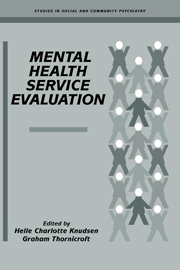Book contents
- Frontmatter
- Contents
- List of contributors
- Foreword
- Preface
- Part I INTRODUCTION
- Part II COMPREHENSIVE SERVICE EVALUATION PROJECTS
- Part III METHODS: MEASUREMENT, STRATEGIES AND NEW APPROACHES
- 8 Strategies of measurement and analyses
- 9 Experimental and quasi-experimental design in evaluative research
- 10 An informal introduction to graphical modelling
- 11 Meta-analysis
- Part IV SYSTEM-LEVEL RESEARCH
- Part V PROGRAMME-LEVEL RESEARCH
- Part VI HEALTH ECONOMICS IN MENTAL HEALTH
- Index
10 - An informal introduction to graphical modelling
from Part III - METHODS: MEASUREMENT, STRATEGIES AND NEW APPROACHES
Published online by Cambridge University Press: 05 August 2016
- Frontmatter
- Contents
- List of contributors
- Foreword
- Preface
- Part I INTRODUCTION
- Part II COMPREHENSIVE SERVICE EVALUATION PROJECTS
- Part III METHODS: MEASUREMENT, STRATEGIES AND NEW APPROACHES
- 8 Strategies of measurement and analyses
- 9 Experimental and quasi-experimental design in evaluative research
- 10 An informal introduction to graphical modelling
- 11 Meta-analysis
- Part IV SYSTEM-LEVEL RESEARCH
- Part V PROGRAMME-LEVEL RESEARCH
- Part VI HEALTH ECONOMICS IN MENTAL HEALTH
- Index
Summary
Introduction
The purpose of this chapter is to give a short introduction to graphical models, a new class of multivariate statistical models characterised by a so-called independence graph representing relationships among variables. Fig. 10.1 shows an independence graph depicting the associations between variables from a comparative study of the social situation of two different cohorts of 70-year-olds in Denmark. Six variables are included in the model - Dwelling, Work, Marriage, Education, Gender and Cohort Year-some of which are connected by undirected edges while others are connected by arrows.
This section gives a very brief introduction to independence graphs and graphical models and reviews some of the advantages of graphical models. The following section will discuss the methodological prerequisites from the social sciences and epidemiology that graphical modelling is related to. The discussion in this section eventually focuses on conditional independence, the fundamental notion on which graphical models are founded. It will also lead to a principle of complete elaboration and a precise definition of the concept of association on which the graphical models are implicitly based. The third section presents the formal definition of graphical models and a few key results from the theory. Finally, we return to the graphical model shown in Fig. 10.1 and discuss some of what this model may tell us about how the data should be analysed.
The independence graph (Fig. 10.1) is one part of the end result of the analysis of the six-dimensional contingency table by graphical models. It is at one and the same time a visual representation of a special log-linear model for the table and a mathematical model in its own right.
The edges and arrows of independence graphs represent direct relationships, that is relationships between pairs of variables where correlations can not be explained by controlling with respect to the remaining variables included in the table. The directions of arrows indicate asymmetrical relationships corresponding to causal or temporal structure. The asymmetrical relationships define a so-called block recursive structure in which all asymmetrical relationships point in one direction only, distinguishing for each pairwise relationship between antecedent, intervening and consequent variables.
- Type
- Chapter
- Information
- Mental Health Service Evaluation , pp. 156 - 175Publisher: Cambridge University PressPrint publication year: 1996
- 7
- Cited by



